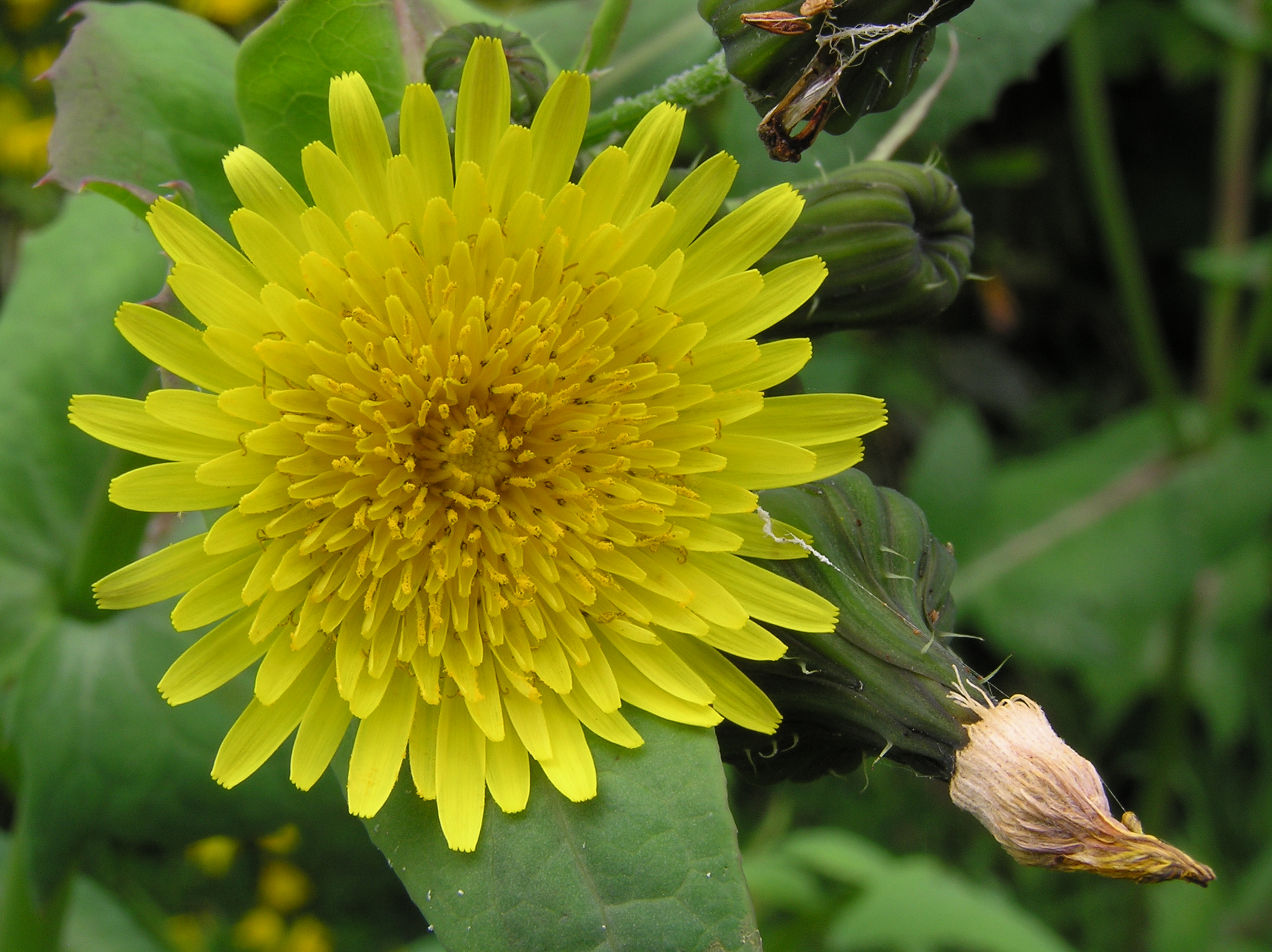- Sonchus
image_width = 280px
image_caption = 3 stages of flowering
regnum =Plant ae
divisio = Magnoliophyta
classis = Magnoliopsida
ordo =Asterales
familia =Asteraceae
tribus =Cichorieae
genus = "Sonchus"
genus_authority = L.
subdivision_ranks = Species
subdivision = "Sonchus asper " - spiny sow thistle
"Sonchus arvensis " - field or perennial sow thistle
"Sonchus dregeanus "
"Sonchus integrifolius "
"Sonchus kirkii " - puha or rauriki
"Sonchus nanus "
"Sonchus oleraceus " - common sow thistle
"Sonchus wilmsii " - milk thistleSow thistles (less commonly hare thistles or hare lettuces) are annual herbs in the genus "Sonchus", after their Ancient Greece name. All are characterized by soft, somewhat irregularly lobed
leaves that clasp the stem and, at least initially, form a basal rosette. The stem contains a milky sap. Flower heads are yellow and range in size from half to one inch in diameter; the florets are all of ray type. Sow thistles are common roadside plants, and while native toEurasia and tropicalAfrica , they are found almost worldwide intemperate regions. Like the truethistle s, sow thistles are in the familyAsteraceae .Mature sow thistle stems can range from 30 cm to 2 m (1 to 6 feet) tall, depending upon species and growing conditions. Colouration ranges from green to purple in older plants. Sow thistles exude a milky
latex when any part of the plant is cut or damaged, and it is from this fact that the plants obtained the common name, "sow thistle", as they were fed to lactating sows in the belief thatmilk production would increase. Sow thistles are known as "milk thistles" in some regions, although truemilk thistle s belong to the genus "Silybum ".Sow thistles have been used as fodder, particularly for
rabbit s, hence the other common names of "hare thistle" or "hare lettuce". They are also edible tohuman s as aleaf vegetable ; old leaves and stalks can be bitter but young leaves have a flavour similar tolettuce . Going by the name "puha" or "rareke" ("raraki") it is frequently eaten inNew Zealand as a vegetable, particularly by the nativeMāori . When cooked it tastes a little similar tochard .In many areas sow thistles are considered
noxious weed s, as they grow quickly in a wide range of conditions and their wind-borneseed s allow them to spread rapidly. "Sonchus arvensis", the perennial sow thistle, is considered the most economically detrimental, as it can crowd commercial crops, is a heavy consumer ofnitrogen insoil s, and can regrow and sprout additional plants from its creepingroot s. However, sow thistles are easily uprooted by hand, and their soft stems present little resistance to slashing or mowing. Mostlivestock will readily devour sow thistle in preference tograss .Sow thistles are common host plants for
aphids . Gardeners may consider this a benefit or a curse; aphids may spread from sow thistle to other plants, but alternatively the sow thistle can encourage the growth of beneficial predators such as hoverflies. In this regard sow thistles make excellentsacrificial plant s. "Sonchus" species are used as food plants by thelarva e of someLepidoptera species includingBroad-barred White ,Grey Chi , The Nutmeg and The Shark.References
* ISBN 0-89672-614-2
* Low, Tim. Wild Herbs of Australia and New Zealand. Rev. ed. Angus and Robertson, 1991. ISBN 0-207-17001-0.External links
* [http://www.nwcb.wa.gov/weed_info/sowthistle.html Washington State Noxious Weed Control Board]
* [http://www.northern.edu/natsource/NOXIOU1/Perenn1.htm Perennial Sowthistle Fact-Sheet]
* [http://www.botanical.com/botanical/mgmh/s/sowthi71.html Botanical.com — sow-thistles]
Wikimedia Foundation. 2010.

